Balkinization
an unanticipated consequence of
Jack M. Balkin
Balkinization Symposiums: A Continuing List
E-mail:
Jack Balkin:
jackbalkin at yahoo.com
Bruce Ackerman
bruce.ackerman at yale.edu
Ian Ayres
ian.ayres at yale.edu
Corey Brettschneider
corey_brettschneider at brown.edu
Mary Dudziak
mary.l.dudziak at emory.edu
Joey Fishkin
joey.fishkin at gmail.com
Heather Gerken heather.gerken at yale.edu
Abbe Gluck abbe.gluck at yale.edu
Mark Graber
mgraber at law.umaryland.edu
Stephen Griffin
sgriffin at tulane.edu
Jonathan Hafetz
jonathan.hafetz at shu.edu
Jeremy Kessler
jkessler at law.columbia.edu
Andrew Koppelman
akoppelman at law.northwestern.edu
Marty Lederman
msl46 at law.georgetown.edu
Sanford Levinson
slevinson at law.utexas.edu
David Luban
david.luban at gmail.com
Gerard Magliocca
gmaglioc at iupui.edu
Jason Mazzone
mazzonej at illinois.edu
Linda McClain
lmcclain at bu.edu
John Mikhail
mikhail at law.georgetown.edu
Frank Pasquale
pasquale.frank at gmail.com
Nate Persily
npersily at gmail.com
Michael Stokes Paulsen
michaelstokespaulsen at gmail.com
Deborah Pearlstein
dpearlst at yu.edu
Rick Pildes
rick.pildes at nyu.edu
David Pozen
dpozen at law.columbia.edu
Richard Primus
raprimus at umich.edu
K. Sabeel Rahmansabeel.rahman at brooklaw.edu
Alice Ristroph
alice.ristroph at shu.edu
Neil Siegel
siegel at law.duke.edu
David Super
david.super at law.georgetown.edu
Brian Tamanaha
btamanaha at wulaw.wustl.edu
Nelson Tebbe
nelson.tebbe at brooklaw.edu
Mark Tushnet
mtushnet at law.harvard.edu
Adam Winkler
winkler at ucla.edu
Compendium of posts on Hobby Lobby and related cases
The Anti-Torture Memos: Balkinization Posts on Torture, Interrogation, Detention, War Powers, and OLC
The Anti-Torture Memos (arranged by topic)
Recent Posts
Symmetry’s Domain II
Just A Few Blogs
ACS Blog
Alas, a Blog
Althouse
Arts and Letters Daily
Atrios (Eschaton)
Bill of Health
Buzzflash.com
Buzz Machine
Cato at Liberty
Juan Cole (Informed Comment)
Concurring Opinions
The Constitution in 2020
Corrente
Crooked Timber
Daily Howler
Daily Kos
Dana Boyd
Brad DeLong
Digby (Hullabaloo)
Discriminations
Daniel Drezner
Kevin Drum (Mother Jones)
Electrolite
En Banc
Eunomia (Daniel Larison)
Fafblog
Michael Froomkin (Discourse.net)
GovLab (Beth Noveck)
Rick Hasen (Election Law)
History News Network
How Appealing
Ignatz (Sam Heldman)
The Importance of (Ernie Miller)
Infolaw
Instapundit
International Economic Law and Policy Blog
IntLawGrrls
Jacob Levy
Jesus' General
Jurisdynamics
The Kitchen Cabinet
Mark Kleiman
Law Blog Central
Larry Lessig
Lawyers, Guns and Money
Liberal Oasis
Brian Leiter's Law School Reports
The Leiter Reports
Marginal Revolution
Megan McArdle
Memeorandum
Metafilter
Mirror of Justice
The New Republic
Newseum
No More Mister Nice Blog
Brendan Nyhan
Opinio Juris
Orcinus
The Originalism Blog
Pandagon
Passport (Foreign Policy)
Overcoming Bias
Political Animal (Washington Monthly)
Political Theory Daily Review
Political Wire (Taegan Goddard)
The Poor Man
Virginia Postrel
Prawfsblawg
Public Reason
Jonathan Rauch
Raw Story
Redstate
ReligiousLeftLaw.com
Reporters Committee For Freedom of the Press
Reproductive Rights Blog
Rothman's Roadmap to the Right of Publicity
SCOTUS Blog
Seeing the Forest
Clay Shirky
The Shifted Librarian
The Situationist
Larry Solum (Legal Theory)
Andrew Sullivan
Talking Points Memo
Talk Left
Tapped
Tbogg
TechPresident
The Paper Chase (Jurist)
Tom Paine
Tom Tomorrow (This Modern World)
Eve Tushnet
Uggabugga
University of Chicago Law School Faculty Blog
Unqualified Offerings
The Volokh Conspiracy
War and Piece (Laura Rozen)
Wampum
Oliver Willis
Wonkette
Written Description
Matthew Yglesias
Yin
Your Choice of Feeds
1. XML
powered by
2. Atom Feed
3. RSS 2.0
Symmetry’s Domain II
Guest Blogger
For the Balkinization symposium on Zachary Price, Constitutional Symmetry: Judging in a Divided Republic (Cambridge University Press, 2024). Mike Greve Constitutional Symmetry is
vintage Zach Price: judicious, learned, lawyerly, fair-minded, unfailingly
respectful of differing opinions and commitments. The book is also admirably
clear about symmetry’s envisioned role in adjudication. It is to operate at a high
level, as opposed to judicial maneuvers that toss opinionated bones now to this
camp, now to the other. It should operate within the framework of a sometimes asymmetric
Constitution and of the judges’ jurisprudential commitments. It is not a rule
but an ethic, an orientation, an all-else-equal preference. I can’t see anything wrong with
that, and I commend Zach for showing, in many thoughtful chapters, what constitutional
symmetry might imply and how it might work in highly contested areas of law and
public debate. I come, then, not to oppose but to sow confusion, or at least to
admit to my own. The symmetry Zach has in mind is
“partisan and ideological.” I get the partisan part: red and blue, fifty-fifty,
polarization, constitutional hardball and flagrant fouls. Symmetry is surely worth
having under those conditions; but it’s also most likely to show up at such
times, is it not? No symmetry can be had when a
Court’s legitimacy hangs on playing out the program of a durable, dominant political
coalition. (The post-New Deal Court’s Constitution never had any Republicans in
it.) When no such coalition exists and none can be expected to emerge any time
soon, judges must anticipate that the partisan worm will turn. Symmetry is the
only plausible course of action. My own worry about the current Court, then,
isn’t so much a lack of partisan symmetry; it’s the Justices’ lack of clarity
and candor with respect to the partisan dimensions of their rulings. I’ll come
back to that. I am much less sure about “ideological”
symmetry. As Zach notes, it doesn’t map onto the partisan divide, for the
simple reason that neither party professes anything resembling a coherent set
of beliefs. The closest one can come, perhaps, is a demographic divide: rural deplorables
who cling to guns and religion, versus urban sophisticates who want to banish
those things. However, a jurisprudence of tribal symmetry is obviously not what
Zach has in mind. Zach’s chapters on
symmetry-in-action effectively disaggregate contentions on hotly contested
issues: guns, religion, affirmative action, voting rights, and more. Symmetric
answers to these sorts of questions, however, tend to be structurally different
from partisan symmetry. Partisan symmetry is generally about decision
rules. The President either gets to fire officers, or he doesn’t. Congressional
committees get to enforce their subpoenas in court, or they don’t. State AGs
get injunctions against the feds in their home courts, or they don’t. You can
favor one arrangement or the other but, barring some gerrymandered contrivance,
evenly matched camps will win some and lose some. Issue-oriented symmetries, in
contrast, usually require distribution rules. Rules of that description
govern zero-sum games, which entail perennial litigation over inches and
chronic instability over time. They are “symmetric” only in the sense of
representing interest group compromises that seem tolerable at the time. On
many of the aforementioned issues, the Supreme Court’s decisions were
intentionally symmetric in this distributional sense. Casey’s “undue
burden” test comes to mind, as does Bakke’s quotas-are-okay-so-long-as-you-lie-about-them
regime. Speaking of which: Zach
cautiously argues that symmetry permits, and may counsel, affirmative action
policies to some degree, in some settings—something like a “Bakke with
teeth,” perhaps, or preferential policies that come at some cost to the
enacting majority, or facially race-blind policies that are reverse-engineered
to produce the desired mix. What exactly, though, is the desired
symmetry on college admissions, and among whom--voters? Large majorities have
voted against affirmative action. Folks
of different colors? That looks like the worst kind of stereotyping. Legal theorists
who variously advocate a “neutrality” or an “anti-subordination” theory of the
Fourteenth Amendment? They’re not going to settle for some artful compromise;
and in any event, who cares? Why not simply argue that formal race
neutrality is the symmetric rule? I get it, I think: that would look
like the conservatives won and the DEI industry lost. But that isn’t how the
world works. If colorblind apostles were truly serious about their meritocratic
convictions, they might want to pursue a disparate impact theory: “Given the
applicant pool, there cannot be more than a dozen black students in any Harvard
Law class. If there are, we’ll assume that HLS discriminated and make the
administrators prove the opposite.” That is the only anti-circumvention rule with
teeth. Thankfully, though, no one has advocated it, and no one will. Thus, the affirmative
action machinery will grind on—more surreptitiously and without the now-toxic
DEI label but efficaciously. Zach acknowledges as much, sans my snark.
And if I understand him correctly, he suggests that neutrality may be the only
rule that holds a promise of remaining stable. It has the added advantage of
telling ideologues on both sides: don’t push too hard. What’s there not to like, or at least to not
find intolerable? Consider a somewhat different
illustration of the baseline problem: the administrative state. In an
insightful chapter, Zach argues that Chevron’s demise (which occurred
after the book went to press) will have asymmetric consequences. Pro-regulatory
constituencies and administrations have a far greater stake in making old
statutes do new tricks than do free-marketeers. Courts, Zach urges, should make
an offsetting move: ramp down State Farm review of the agency’s
reasonableness. I am totally on board with that program, for conventional
(okay: “anti-administrativist”) reasons: a world in which courts cut agencies
slack on the law and then probe their record and policy decisions for
reasonableness is Marbury upside down. In contrast, symmetry between
pro- and anti-regulatory constituencies strikes me as a questionable objective. If you believe that the world is
one vast common pool, to be managed by whosoever runs OIRA, why then yes:
ensure parity and symmetry between regulatory beneficiaries and regulated
parties. If, on the other hand, you believe that the Constitution makes no
sense except against a robust presumption in favor of private orderings, you
will want the nudgers and hatchers of great plans to overcome serious obstacles
before bothering the rest of us. This, I submit, is one of the instances in
which the Constitution is deeply, deliberately, incontrovertibly asymmetric. Any supposed symmetry between
pro- and anti-regulatory camps is illusory anyhow, because only one of the
camps is armed. Thus, if a spotted owl (an Oregon spotted owl. She is
genetically identical to the non-endangered California spotted owl, except she
parts her hair on the left) might one day land on your property, in the spot
where you intended to build your house, the bird wins and you lose. Likewise, if
you can no longer buy a washer or dryer that works, that’s on account
“regulatory beneficiaries” who earn a living by muscling public values into private
abodes. Perhaps, the “symmetry” one might
want is between the rulers and the ruled. As it happens, Chevron speaks or
spoke to that question, though not in a good way. “We realize,” it permitted
immigration authorities to say, “that you based your citizenship application on
our rule, which the courts had declared ‘reasonable.’ But for the purposes of your
pending proceeding we have a new reasonable rule and guess what, sucker:
you’re deported.” (Real case, Tenth Circuit. https://www.ca10.uscourts.gov/sites/ca10/files/opinions/01019510019.pdf
It made then-Judge Gorsuch’s blood boil.) A government that already holds all
the cards gets to play with house money and change the rules midstream: that was
Chevron. It does not seem sporting, or symmetric. My musings over the baseline
problem are a long-winded way of saying this: I suspect that symmetry’s true
domain is partisan politics, where the baseline is both clear and highly
salient. And here, Zach may actually be under-pleading a very strong case. Start with Rick Pildes’s and
Daryl Levinson’s justly famous article: we have a separation of parties, not
powers. https://papers.ssrn.com/sol3/papers.cfm?abstract_id=890105
Whether and how one might adjust separation-of-powers jurisprudence to that
reality is a very hard question. One thing is certain, though: if you cram
obviously partisan brawls through a framework of empire-building “branches,”
you are bound to make bad mistakes and look a tad silly in the process. A
single example shall suffice. The Obama Administration’s duplicitous
lawyering in the fight over the Defense of Marriage Act produced several
Supreme Court opinions on the question as to whether BLAG might have standing
to defend DOMA. Leave aside that no one called “BLAG” should ever have
standing: BLAG (in British English, meaning “obtain by deception”) was the
“Bipartisan Legal Advisory Group,” where three Republicans outvoted two Dems
and went to town. Yet the Justices’ opinions earnestly burble about standing
for legislators who assert “institutional interests”—as if the GOP BLAGgers had
any such thing in mind; as if they were credible representatives of the
institution. To this day, legislators’ standing has remained a disaster area.
How many legislators do you need? Do they have to be committee members? Do you
need one chamber, or both? What if members from both parties purport to
represent “the Congress,” on opposite sides of the same case? All highly
manipulable, and therefore manipulated. Zach Price to the rescue: focus
squarely on the partisan dimension; aim for symmetry over the long haul. My own
choice would be to throw “institutional” litigants out on their rear ends. (Federal
courts did not entertain any such “cases” until fifteen constitutional minutes
ago.) Failing that, cases involving congressional subpoenas directed at
executive officials may provide a template. In a leading case, https://www.supremecourt.gov/opinions/19pdf/19-715_febh.pdf
Chief Justice Roberts subjected such subpoena proceedings, in federal court, to
a multi-part test—each prong a vague standard; each highly fact-intensive and
time-consuming. Would I defend that
ruling as a matter of high constitutional principle? Not while I’m trying to
keep my job. Might it be a symmetric rule and, equally important, the right symmetric
rule? Absolutely. It tells rabble-rousers on both sides: you’ll never see the
end of day in these proceedings. Don’t even try. A final point along this line (a
perennial bee in my bonnet, and thanks to Zach for giving it air in his book): federalism
has become a partisan domain, and the Supreme Court has made a mess of it. This
issue, too, illustrates the importance of not just choosing a symmetric
rule, but the right symmetric rules. Zach’s principal example is National
Pork Producers Council v. Ross, https://www.supremecourt.gov/opinions/22pdf/21-468_5if6.pdf
where the Court upheld a California law prohibiting the sale of pork products
unless the pigs were raised under conditions deemed humane in La Jolla.
(Sunlight, space, and a weekly massage. From spa to table.) California has virtually
no pork producers. Thence, the state’s extraterritorial California Uber
Alles https://www.youtube.com/watch?v=R-rDQs5NOP4
policy (one of many). The Supremes waved this through.
In a particularly preposterous paragraph, the Court invoked, of all things,
symmetry: if we ding this law just because California has market power, Rhode
Island could do the same thing and get away with it. Lo, then: every state’s
legislative jurisdiction extends from sea to shining sea. In a related
decision, https://www.supremecourt.gov/opinions/22pdf/21-1168_kifl.pdf
the Court held (in an opinion authored, like Pork Producers, by Justice
Gorsuch) that state courts’ judicial, general jurisdiction extends to anyone
who registers to do business in the state, meaning everyone. Such universal
jurisdiction rulings are pristinely symmetrical in a formal sense. They are
also a menace to a sensible constitutional order, and highly conducive to
partisan strife. Alas, the Supreme Court has
produced a raft of decisions in this vein. Most fatefully, in Massachusetts
v. EPA (2007) https://supreme.justia.com/cases/federal/us/549/497/
the Court granted the Commonwealth standing to compel EPA to make an “endangerment
finding” with respect to greenhouse gases, which might prompt some sort of
federal carbon regulation, which might reduce sea level rise by a millimeter a
century hence. Supreme Court to Bostonians: if you like your city, you can keep
it. This is called “Mass v. EPA
standing,” because nothing of the sort had been seen before. And while the
majority opinion oozes concern over the poor, pitiful states and their right to
make EPA do its duty, the rank partisan dimension of the ruling should have
stared the Justices in the face. The dozen or so blue states that supported
Massachusetts were fiercely opposed by a roughly equal number of red,
energy-intensive states, which understood this wicked, one-sided game all too
well. Blue states, bleeding citizens and their taxable income to more
hospitable red states, have every incentive to raise their rivals’ costs. That
is what the carbon war is about, and in a very real sense the Supreme Court
unleashed it. Can one think of symmetric rules
for a more harmonious federalism? Sure. That, though, presupposes judges and
Justices who are cognizant and mindful of partisan symmetries and dynamics. To
that end, Constitutional Symmetry is a terrific exploration of this
fraught terrain.
Posted
9:30 AM
by Guest Blogger [link]
Books by Balkinization Bloggers

Linda C. McClain and Aziza Ahmed, The Routledge Companion to Gender and COVID-19 (Routledge, 2024)

David Pozen, The Constitution of the War on Drugs (Oxford University Press, 2024)

Jack M. Balkin, Memory and Authority: The Uses of History in Constitutional Interpretation (Yale University Press, 2024)
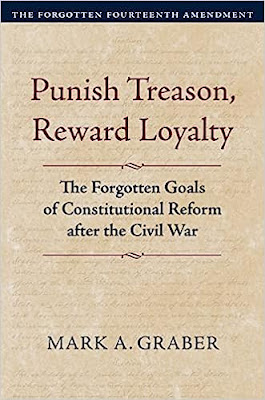
Mark A. Graber, Punish Treason, Reward Loyalty: The Forgotten Goals of Constitutional Reform after the Civil War (University of Kansas Press, 2023)
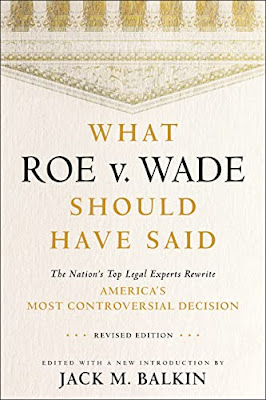
Jack M. Balkin, What Roe v. Wade Should Have Said: The Nation's Top Legal Experts Rewrite America's Most Controversial Decision - Revised Edition (NYU Press, 2023)

Andrew Koppelman, Burning Down the House: How Libertarian Philosophy Was Corrupted by Delusion and Greed (St. Martin’s Press, 2022)

Gerard N. Magliocca, Washington's Heir: The Life of Justice Bushrod Washington (Oxford University Press, 2022)
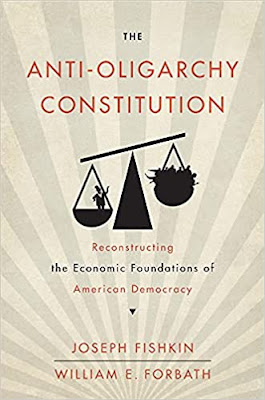
Joseph Fishkin and William E. Forbath, The Anti-Oligarchy Constitution: Reconstructing the Economic Foundations of American Democracy (Harvard University Press, 2022)
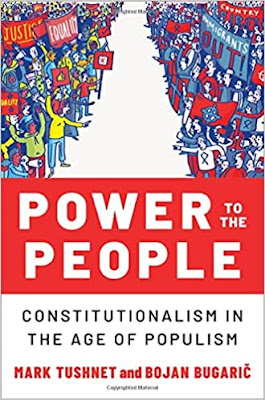
Mark Tushnet and Bojan Bugaric, Power to the People: Constitutionalism in the Age of Populism (Oxford University Press 2021).

Mark Philip Bradley and Mary L. Dudziak, eds., Making the Forever War: Marilyn B. Young on the Culture and Politics of American Militarism Culture and Politics in the Cold War and Beyond (University of Massachusetts Press, 2021).

Jack M. Balkin, What Obergefell v. Hodges Should Have Said: The Nation's Top Legal Experts Rewrite America's Same-Sex Marriage Decision (Yale University Press, 2020)

Frank Pasquale, New Laws of Robotics: Defending Human Expertise in the Age of AI (Belknap Press, 2020)

Jack M. Balkin, The Cycles of Constitutional Time (Oxford University Press, 2020)

Mark Tushnet, Taking Back the Constitution: Activist Judges and the Next Age of American Law (Yale University Press 2020).

Andrew Koppelman, Gay Rights vs. Religious Liberty?: The Unnecessary Conflict (Oxford University Press, 2020)

Ezekiel J Emanuel and Abbe R. Gluck, The Trillion Dollar Revolution: How the Affordable Care Act Transformed Politics, Law, and Health Care in America (PublicAffairs, 2020)

Linda C. McClain, Who's the Bigot?: Learning from Conflicts over Marriage and Civil Rights Law (Oxford University Press, 2020)
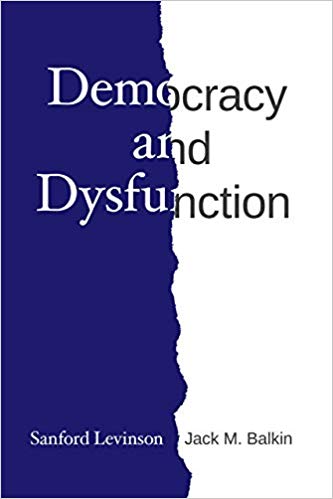
Sanford Levinson and Jack M. Balkin, Democracy and Dysfunction (University of Chicago Press, 2019)

Sanford Levinson, Written in Stone: Public Monuments in Changing Societies (Duke University Press 2018)

Mark A. Graber, Sanford Levinson, and Mark Tushnet, eds., Constitutional Democracy in Crisis? (Oxford University Press 2018)

Gerard Magliocca, The Heart of the Constitution: How the Bill of Rights became the Bill of Rights (Oxford University Press, 2018)

Cynthia Levinson and Sanford Levinson, Fault Lines in the Constitution: The Framers, Their Fights, and the Flaws that Affect Us Today (Peachtree Publishers, 2017)

Brian Z. Tamanaha, A Realistic Theory of Law (Cambridge University Press 2017)

Sanford Levinson, Nullification and Secession in Modern Constitutional Thought (University Press of Kansas 2016)

Sanford Levinson, An Argument Open to All: Reading The Federalist in the 21st Century (Yale University Press 2015)

Stephen M. Griffin, Broken Trust: Dysfunctional Government and Constitutional Reform (University Press of Kansas, 2015)

Frank Pasquale, The Black Box Society: The Secret Algorithms That Control Money and Information (Harvard University Press, 2015)

Bruce Ackerman, We the People, Volume 3: The Civil Rights Revolution (Harvard University Press, 2014)
Balkinization Symposium on We the People, Volume 3: The Civil Rights Revolution

Joseph Fishkin, Bottlenecks: A New Theory of Equal Opportunity (Oxford University Press, 2014)

Mark A. Graber, A New Introduction to American Constitutionalism (Oxford University Press, 2013)

John Mikhail, Elements of Moral Cognition: Rawls' Linguistic Analogy and the Cognitive Science of Moral and Legal Judgment (Cambridge University Press, 2013)

Gerard N. Magliocca, American Founding Son: John Bingham and the Invention of the Fourteenth Amendment (New York University Press, 2013)

Stephen M. Griffin, Long Wars and the Constitution (Harvard University Press, 2013)

Andrew Koppelman, The Tough Luck Constitution and the Assault on Health Care Reform (Oxford University Press, 2013)

James E. Fleming and Linda C. McClain, Ordered Liberty: Rights, Responsibilities, and Virtues (Harvard University Press, 2013)
Balkinization Symposium on Ordered Liberty: Rights, Responsibilities, and Virtues

Andrew Koppelman, Defending American Religious Neutrality (Harvard University Press, 2013)

Brian Z. Tamanaha, Failing Law Schools (University of Chicago Press, 2012)

Sanford Levinson, Framed: America's 51 Constitutions and the Crisis of Governance (Oxford University Press, 2012)

Linda C. McClain and Joanna L. Grossman, Gender Equality: Dimensions of Women's Equal Citizenship (Cambridge University Press, 2012)

Mary Dudziak, War Time: An Idea, Its History, Its Consequences (Oxford University Press, 2012)

Jack M. Balkin, Living Originalism (Harvard University Press, 2011)

Jason Mazzone, Copyfraud and Other Abuses of Intellectual Property Law (Stanford University Press, 2011)

Richard W. Garnett and Andrew Koppelman, First Amendment Stories, (Foundation Press 2011)

Jack M. Balkin, Constitutional Redemption: Political Faith in an Unjust World (Harvard University Press, 2011)

Gerard Magliocca, The Tragedy of William Jennings Bryan: Constitutional Law and the Politics of Backlash (Yale University Press, 2011)

Bernard Harcourt, The Illusion of Free Markets: Punishment and the Myth of Natural Order (Harvard University Press, 2010)

Bruce Ackerman, The Decline and Fall of the American Republic (Harvard University Press, 2010)
Balkinization Symposium on The Decline and Fall of the American Republic

Ian Ayres. Carrots and Sticks: Unlock the Power of Incentives to Get Things Done (Bantam Books, 2010)

Mark Tushnet, Why the Constitution Matters (Yale University Press 2010)
Ian Ayres and Barry Nalebuff: Lifecycle Investing: A New, Safe, and Audacious Way to Improve the Performance of Your Retirement Portfolio (Basic Books, 2010)
.jpg)
Jack M. Balkin, The Laws of Change: I Ching and the Philosophy of Life (2d Edition, Sybil Creek Press 2009)

Brian Z. Tamanaha, Beyond the Formalist-Realist Divide: The Role of Politics in Judging (Princeton University Press 2009)
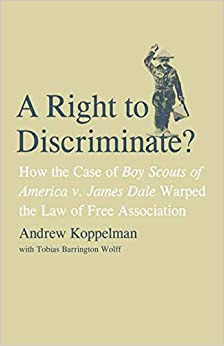
Andrew Koppelman and Tobias Barrington Wolff, A Right to Discriminate?: How the Case of Boy Scouts of America v. James Dale Warped the Law of Free Association (Yale University Press 2009)

Jack M. Balkin and Reva B. Siegel, The Constitution in 2020 (Oxford University Press 2009)
Heather K. Gerken, The Democracy Index: Why Our Election System Is Failing and How to Fix It (Princeton University Press 2009)

Mary Dudziak, Exporting American Dreams: Thurgood Marshall's African Journey (Oxford University Press 2008)

David Luban, Legal Ethics and Human Dignity (Cambridge Univ. Press 2007)

Ian Ayres, Super Crunchers: Why Thinking-By-Numbers is the New Way to be Smart (Bantam 2007)

Jack M. Balkin, James Grimmelmann, Eddan Katz, Nimrod Kozlovski, Shlomit Wagman and Tal Zarsky, eds., Cybercrime: Digital Cops in a Networked Environment (N.Y.U. Press 2007)

Jack M. Balkin and Beth Simone Noveck, The State of Play: Law, Games, and Virtual Worlds (N.Y.U. Press 2006)

Andrew Koppelman, Same Sex, Different States: When Same-Sex Marriages Cross State Lines (Yale University Press 2006)
Brian Tamanaha, Law as a Means to an End (Cambridge University Press 2006)
Sanford Levinson, Our Undemocratic Constitution (Oxford University Press 2006)
Mark Graber, Dred Scott and the Problem of Constitutional Evil (Cambridge University Press 2006)
Jack M. Balkin, ed., What Roe v. Wade Should Have Said (N.Y.U. Press 2005)
Sanford Levinson, ed., Torture: A Collection (Oxford University Press 2004)
Balkin.com homepage
Bibliography
Conlaw.net
Cultural Software
Writings
Opeds
The Information Society Project
BrownvBoard.com
Useful Links
Syllabi and Exams